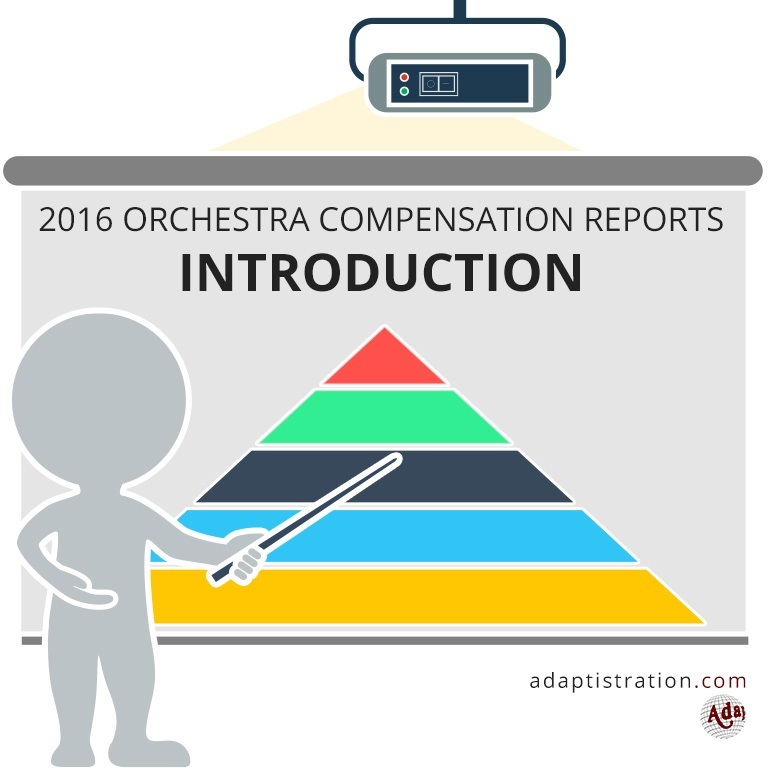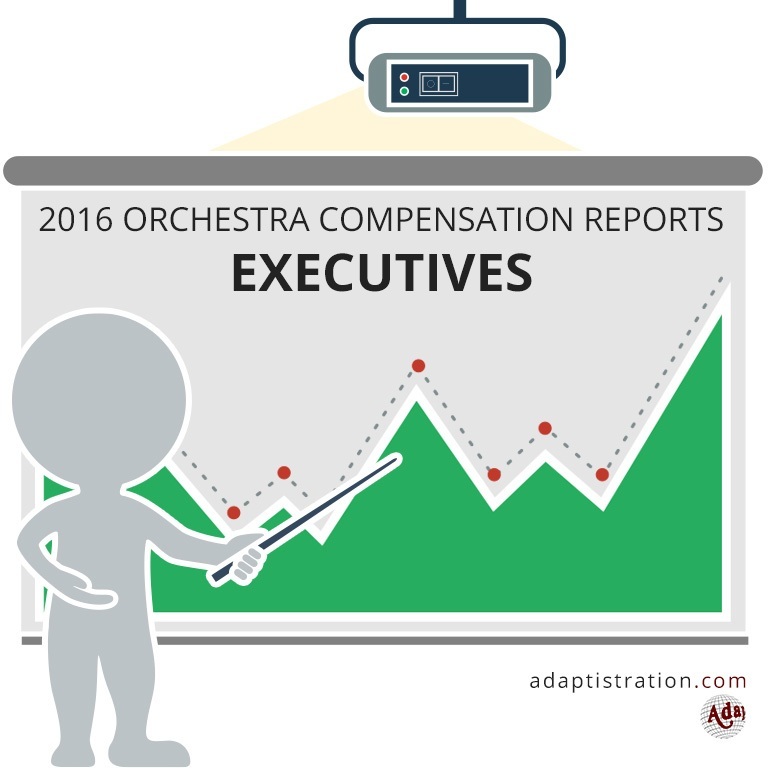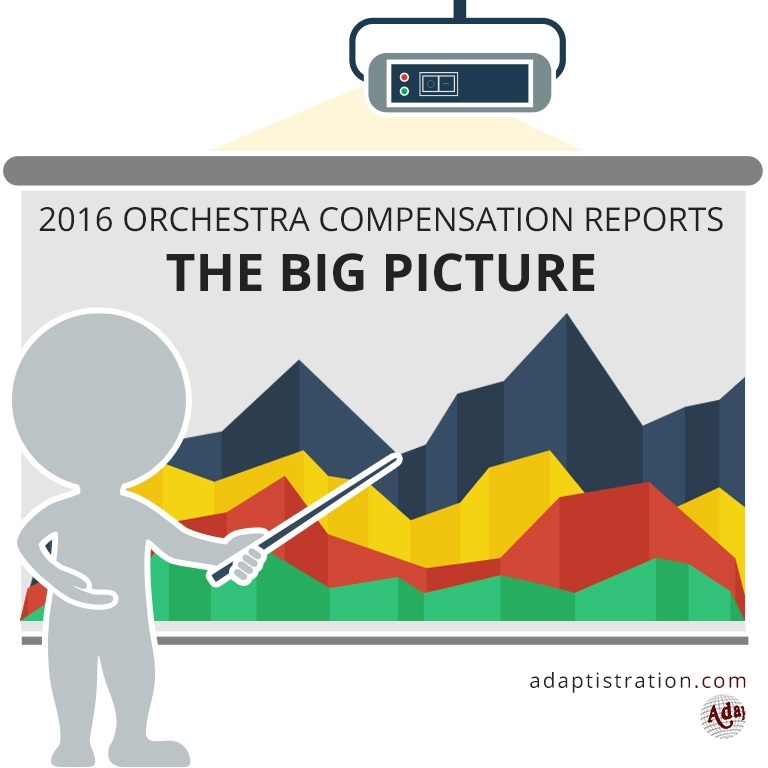Next in this series of compensation reports is the comparison between music directors, concertmasters, and base musicians for ICSOM & IGSOBM ensembles. Much like their administrative counterparts, music directors serve as the executive “manager” for nearly all things artistic, at the top level, within an orchestra (although that model is beginning to change). As such, they should be subject to the same amount of scrutiny regarding their level of performance on and off stage and if they are adequately fulfilling all of their duties.
Last year, music directors were at the top of the nonprofit compensation scale. They were earning so much (over $1,000,000) they came under scrutiny of the IRS, who examined orchestras as part of a larger investigation into nonprofit executive compensation.
Based on last year’s figures, the average music director earned 794% more than the average musician base salary, that’s twice as much as executive directors earned over the musician base salary.
We already know that the average ICSOM executive director earned 10.61% over the previous year so let’s see what the numbers tell us about how the situation for music directors has changed….
Where The Numbers Come From
The following “Music Director compensation” and “Concertmaster Compensation” figures were obtained from their respective orchestra’s 2003 IRS Form 990.
The “musician base salary” figures were obtained from records collected by the AFM and IGSOBM (Seattle) for the 2002-2003 concert season (which corresponds with the 2003 IRS Form 990).
The music director and concertmaster compensation figures include the combined amounts reported as what the IRS classifies as “compensation” and “contributions to employee benefit plans & deferred compensation”. However, each orchestra does not always report figures for the latter category. In the case of some music directors, they are paid separately for their services as conductors and as music directors. In such cases, these figures have been listed cumulatively and notated as such.
The musician base salary figures collected by the AFM are done so on an annual basis and reported in a booklet entitled Wage Scales & Conditions in the Symphony Orchestra. Additional updates were obtained from ICSOM Settlement Bulletins, prepared by each respective orchestra’s negotiation committee and published at the ICSOM website.
Adaptistration makes no claim to the accuracy of information from documents compiled by external sources.
These figures do not include any of the opera or ballet organizations which are members of ICSOM or IGSOBM.
How Things Compare To Last Year – Music Directors
- According to these figures, the average ICSOM music director earns 865% more than a base salary musician, which is an 8.94% increase over last year’s figure of 794%.
- Compared to the figures from 2002, the average ICSOM music director compensation increased 14.25% as compared to the average ICSOM base musician salary increase of 3.83%.
How Things Compare To Last Year – Concertmasters
- According to these figures, the average ICSOM concertmaster earns 225% more than a base salary musician, which is a marginal 0.44% increase over last year’s figure of 224%.
- Compared to the figures from 2002, the average ICSOM concertmaster compensation increased 4.16% which was slightly ahead of the increase in the average ICSOM base musician salary increase of 3.83%.
Who Earns The Most? Music Directors
Much like the division between the executive director pay ranks, the music directors at the top of the pack are head and shoulders above their colleagues with their earnings from a single ensemble (we’ll be talking about double, triple, and even quadruple dipping later).
Five conductors shared space in the “million dollar club” (due to their total music director expenditures being divided between an outgoing and incoming conductor, Philadelphia is not included):
- New York’s Lorin Maazel earned $2,283,425
- Chicago’s Daniel Barenboim earned $2,062,200
- San Francisco’s Michael Tilson Thomas earned $1,504,769
- Los Angeles’ Esa-Pekka Salonen earned $1,206,697
- Pittsburgh’s Mariss Jansons just scraped by earning $1,143,297
Who Earns The Most? Concertmasters
Due to the nature of the position, the ranking of concertmasters tends to fluctuate more than music or executive directors. For example, many concertmasters’ compensation will reflect payment for performing solo work with their orchestra. That, in combination with other annual changes in responsibilities, can result in large changes to their compensation from one year to the next.
The top five concertmasters earn salaries which are much closer as compared to music directors at the top of the pay scale (Chicago lists two musicians as “concertmaster” on their 990, only the highest paid of the two is represented in the chart above):
- Cleveland’s William Preucil earned $372,233
- New York’s Glenn Dicterow earned $366,316
- San Francisco’s Alexander Bratschik earned $361,429
- Boston’s Malcolm Lowe earned $355,647
- Los Angeles’ Martin Chalifour earned $343,667
Who Gained The Most?
Although they may not earn as much as the music directors on the top of the list, these maestros enjoyed more than nearly double the average increase in compensation:
- Charlotte’s Christof Perick received a 56.52% increase.
- Detroit’s Neemi Järvi received a 53.92% increase (although he accepted a 39.90% reduction in pay the previous year).
- Phoenix’s Herman Michael received a 42.00% increase.
- Fort Worth’s Miguel Harth-Bedoya received a 41.30% increase.
- New York’s Lorin Maazel received a 37.89% increase.
- Syracuse’s Daniel Hege received a 30.43% increase.
- Alabama’s Richard Westerfield received a 27.91% increase.
Unfortunately, there’s been a disturbing trend among orchestras which discourages tracking the percent change in concertmaster compensation. The IRS only requires each organization to list the top five employees who earn over $50,000 on their IRS Form 990. As such, concertmasters tend to slip in and out of that “top five” list more and more as V.P. and Director level managers appear to be earning high salaries at a faster rate.
The result is that effectively tracking the percentage change among concertmasters is not readily feasible.
Conclusions
Last year’s music director compensation report examined whether or not music directors were worth such large salaries. They don’t spend as much time at their ensembles as do musicians or managers and most only conduct a dozen or so concert series every season, all of which allows them ample time to earn significant amounts of additional income through guest conducting opportunities. Many don’t even live in the communities they serve (a phenomena called “fly in, fly out” conductors).
By comparison, concert masters certainly have a reduced work load compared to their peer musicians (which also allows them increased capability to earn additional performance income) but it is very uncommon not to find a concertmaster who does not reside and contribute their musical skills to the community in some fashion.
The problem surrounding determining what constitutes appropriate compensation for music directors is more difficult than with executive directors. Those complications are also compounded by the fact that much of the artistic criteria are subjective (and most board members are not qualified to make those decisions).
Add to the mix that due to their superior earning capability, music directors employ efficient private representation (typically referred to as “managers”, but they are not to be confused with orchestra administrators). They typically work on commission and therefore the more their clients earn, the more they earn.
Fortunately, some clever individuals figured out how to cut through much of this nonsense back in the 14th century when William of Ockham devised what is now known as the philosophical principle, Ockham’s Razor (also spelled “Occam’s”). In a nutshell, it dictates that you should not make more assumptions than you need and that the simplest of multiple solutions is typically preferred.
Following that advice ask yourself the following questions and apply Ockham’s Razor to your decision making process:
- Is the music director in your community 865% more valuable than a base musician?
- Are they 196% more valuable than the concertmaster?
- Are they 99% more valuable than the executive director?
Why?
Another question worth considering is do you think orchestras utilize an evaluation process which provides input from musicians and managers to determine raises, etc?




I’m a little confused by this particular quote: “By comparison, concert masters certainly have a reduced work load compared to their peer musicians…” I’m a title chair violinist in a large ROPA orchestra, and I’ll admit that my experiences are limited to a slice of similarly-sized orchestras, plus a select group of ICSOM orchestras that may not be representative. But in those orchestras, concertmasters seemed to be very active, with a comparable service load to the rest of the orchestra, and bowing, solo, and chamber music duties in addition to that service count. While there are several high-profile concertmasters in big budget orchestras that are definitely exempt from service groups and can thus “earn additional performance income,” my impression had been that they were in the minority of orchestras, especially when you include some of the larger ROPA orchestras in the mix. I’d welcome feedback on my point of view.
I believe that Drew’s point (and I think he’s drawing attention to the small percentage a typical section player makes compared to a concertmaster’s salary) is valid, and is very worthy of discussion. However, as an assistant principal, I would say that the onstage demands of sitting principal, which I do occasionally, are greater than when sitting assistant, and would argue that this holds true for the concertmaster position. On those occasions when I was principal, my “offstage” duties for those concerts measurably increased. As we debate these points, I just wanted to put in my two cents on what I believe are the very real and significant on- and off-stage responsibilities that come with the position.
Merwin offers some intriguing points. In particular, she plays in one of the top tier ROPA orchestras, which compared to their ICSOM peers may have some dramatically different work requirements for concertmasters. In the smallest budget ROPA ensembles, the concertmaster may be the only “regularly” employed musician besides the music director. In those instances, they may actually work more than section players because not all sections players are guaranteed every service with the ensembles, whereas the concertmaster does have a guarantee.
Furthermore, the reason concertmasters were included as a separate figure was because they are typically the only other musician in the ensemble who maintains a separate contract in a similar fashion to the music director. That means they serve at the pleasure of the board and are not included lock stock and barrel in the collective bargaining agreement, which dictates the bulk of wages for the remaining musicians. This all leads to the same discussions of whether or not each individual concertmaster justifies their respective pay.
The other purpose behind including concertmaster compensation was not to compare their salary next to base musicians so much as to show the difference in pay between musicians-concertmaster vs. concertmaster-music director. The average figures say that the jump between each category is just about equal, which leads to a discussion about whether or not each jump in compensation is warranted by the amount of work and expectations for each position.
The only other issue I would point out, especially for those who are neither musicians nor managers, is that a principal musician (someone who leads their respective section) is a distinctly different role as compared to concertmasters and music directors. They rarely have separate contracts which are renewed at the decision of the board. Although they certainly earn much more than base wages, they do have increased amount of responsibilities and are not exempt from the types of services which music directors and concertmasters are.
For some examples of the disconnect in compensation; in Philadelphia Orchestra’s 2003 990 they list the concertmaster pay as $259,000, while the principal viola earns $192,00, and the base pay is 98,800. In North Carolina, the concertmaster earns $106,800 while the principal trumpet earns $81,854, and the base pay is $43,000.